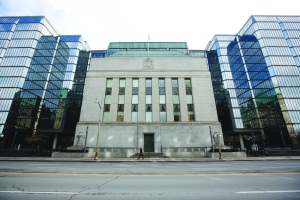Central Asia
Bank of Canada to start jumbo rate cuts by December, says CIBC


The Bank of Canada building in Ottawa. Canadian Imperial Bank of Commerce says policymakers led by Governor Tiff Macklem will reduce the policy rate by 50 basis points at each meeting in December and January.
One of the country’s biggest lenders says the Bank of Canada will accelerate the pace of monetary easing in order to stave off recession.
Canadian Imperial Bank of Commerce says policymakers led by Governor Tiff Macklem will reduce the policy rate by 50 basis points at each meeting in December and January, according to new forecasts released on Thursday. The lender expects the central bank to end the easing cycle next June with a policy rate of 2.25%. The pace of cuts is faster and deeper than what most economists expect, according to a Bloomberg survey from last month.
“It really is time to declare victory in the battle against inflation and get the economy moving again,” Avery Shenfeld, CIBC’s chief economist, said in a phone interview. “There’s no reason not to speed up the process of getting interest rates down materially.”
The forecast change comes amid mounting concerns that Canada’s labour market and growth are weakening at a quicker pace than expected. Last week, jobs data showed the economy added 22,100 jobs in August, and while there’s no widespread layoffs, the unemployment rate surprisingly jumped to 6.6%.
The rise in joblessness is concentrated among young Canadians and newcomers, but it’s also spreading to prime-age workers, Shenfeld said, adding that Canada’s unemployment rate could rise to 6.8 or 6.9% in coming months. It’s not Shenfeld’s base case but he won’t rule out a jumbo cut at the central bank’s next meeting on October 23. The Bank of Canada started reducing the benchmark overnight rate in June, and has since lowered it by 25 basis points at its July and September meetings, bringing the rate to 4.25% from 5% at the peak of the hiking cycle.
Last week, Macklem reiterated that officials could cut rates by 50 basis points or more if inflation and the economy slowed faster than expected. Still, he countered that possibility by noting that pausing cuts was also on the table in the case of stronger growth or persistent inflation.
National Bank of Canada also anticipates a 50 basis point cut before the end of this year. It sees the central bank’s policy rate reaching 3.5% this year and before ending the easing cycle next year at 2.75%, which is the estimated midpoint of the so-called neutral rate — where borrowing costs neither stimulate nor restrict economic growth.
Former Bank of Canada Governor Stephen Poloz said separately on Thursday there may be a case for cutting rates beyond that midpoint “if the downside risks do build up more” to cushion the economy.
While he stopped short of calling a recession, Poloz told BNN Bloomberg Television: “We should be prepared for one, not pretend it can’t happen.”
CIBC and National Bank joined Citibank’s Veronica Clark, who was one of the first forecasters to call for a 50 basis point cut this cycle, and expects one at the next meeting in October.
The rest of the top Canadian lenders — Bank of Montreal, Toronto Dominion Bank, Royal Bank of Canada and the Bank of Nova Scotia — still expect Macklem to ease borrowing costs in 25 basis-point increments.
“Rates are now too high for the economy’s own good and they can afford to front load some of their reductions,” CIBC’s Shenfeld said, adding that officials may wish to stimulate the country’s stagnating housing market.
Canadian Imperial Bank of Commerce says policymakers led by Governor Tiff Macklem will reduce the policy rate by 50 basis points at each meeting in December and January, according to new forecasts released on Thursday. The lender expects the central bank to end the easing cycle next June with a policy rate of 2.25%. The pace of cuts is faster and deeper than what most economists expect, according to a Bloomberg survey from last month.
“It really is time to declare victory in the battle against inflation and get the economy moving again,” Avery Shenfeld, CIBC’s chief economist, said in a phone interview. “There’s no reason not to speed up the process of getting interest rates down materially.”
The forecast change comes amid mounting concerns that Canada’s labour market and growth are weakening at a quicker pace than expected. Last week, jobs data showed the economy added 22,100 jobs in August, and while there’s no widespread layoffs, the unemployment rate surprisingly jumped to 6.6%.
The rise in joblessness is concentrated among young Canadians and newcomers, but it’s also spreading to prime-age workers, Shenfeld said, adding that Canada’s unemployment rate could rise to 6.8 or 6.9% in coming months. It’s not Shenfeld’s base case but he won’t rule out a jumbo cut at the central bank’s next meeting on October 23. The Bank of Canada started reducing the benchmark overnight rate in June, and has since lowered it by 25 basis points at its July and September meetings, bringing the rate to 4.25% from 5% at the peak of the hiking cycle.
Last week, Macklem reiterated that officials could cut rates by 50 basis points or more if inflation and the economy slowed faster than expected. Still, he countered that possibility by noting that pausing cuts was also on the table in the case of stronger growth or persistent inflation.
National Bank of Canada also anticipates a 50 basis point cut before the end of this year. It sees the central bank’s policy rate reaching 3.5% this year and before ending the easing cycle next year at 2.75%, which is the estimated midpoint of the so-called neutral rate — where borrowing costs neither stimulate nor restrict economic growth.
Former Bank of Canada Governor Stephen Poloz said separately on Thursday there may be a case for cutting rates beyond that midpoint “if the downside risks do build up more” to cushion the economy.
While he stopped short of calling a recession, Poloz told BNN Bloomberg Television: “We should be prepared for one, not pretend it can’t happen.”
CIBC and National Bank joined Citibank’s Veronica Clark, who was one of the first forecasters to call for a 50 basis point cut this cycle, and expects one at the next meeting in October.
The rest of the top Canadian lenders — Bank of Montreal, Toronto Dominion Bank, Royal Bank of Canada and the Bank of Nova Scotia — still expect Macklem to ease borrowing costs in 25 basis-point increments.
“Rates are now too high for the economy’s own good and they can afford to front load some of their reductions,” CIBC’s Shenfeld said, adding that officials may wish to stimulate the country’s stagnating housing market.







